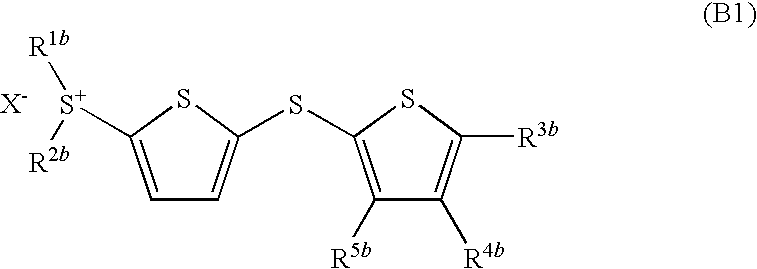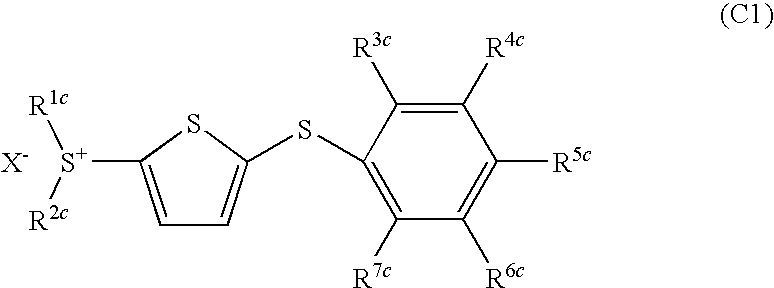Photoacid generator and photoreactive composition
a generator and photoreactive technology, applied in the field of photoacid generator and photoreactive composition, can solve the problem of insufficient reaction rate of photoreactive composition, and achieve the effect of reducing yield
- Summary
- Abstract
- Description
- Claims
- Application Information
AI Technical Summary
Benefits of technology
Problems solved by technology
Method used
Image
Examples
example a1
[0177]In a 100 mL four-necked flask equipped with a stirrer, a thermometer and a condenser, 5.2 g (0.02 mol) of bis(4-methoxyphenyl)sulfoxide, 2.0 g (0.01 mol) of 2,2′-dithienyl sulfide and 10.2 g (0.1 mol) of acetic anhydride were charged and 7.7 g (0.08 mol) of methanesulfonic acid was added dropwise over 1 hour while maintaining the inner temperature at 0 to 10° C. After completion of the dropwise addition, stirring was conducted for 2 hours while maintaining at the same temperature to obtain a reaction solution as a condensation reaction product.
[0178]In a 200 mL four-necked flask equipped with a stirrer, a thermometer and a condenser, 3.7 g (0.02 mol) of potassium hexafluorophosphate, 40 g of water and 30 g of monochlorobenzene were charged and the entire amount of the reaction solution was added dropwise over 30 minutes while maintaining the inner temperature at 30 to 50° C. After stirring at 40 to 50° C. for 30 minutes, the monochlorobenzene layer was separated and monochloro...
example a2
[0184]In a 100 mL four-necked flask equipped with a stirrer, a thermometer and a condenser, 6.9 g (0.02 mol) of bis(4-n-butoxyphenyl)sulfoxide, 2.0 g (0.01 mol) of 2,2′-dithienyl sulfide and 10.2 g (0.1 mol) of acetic anhydride were charged and 7.7 g (0.08 mol) of methanesulfonic acid was added dropwise over 1 hour while maintaining the inner temperature at 0 to 10° C. After completion of the dropwise addition, stirring was conducted for 2 hours while maintaining at the same temperature to obtain a reaction solution as a condensation reaction product.
[0185]In a 200 mL four-necked flask equipped with a stirrer, a thermometer and a condenser, 3.7 g (0.02 mol) of potassium hexafluorophosphate, 40 g of water and 30 g of monochlorobenzene were charged and the entire amount of the reaction solution was added dropwise over 30 minutes while maintaining the inner temperature at 30 to 50° C. After stirring at 40 to 50° C. for 30 minutes, the monochlorobenzene layer was separated and monochlor...
example a3
[0191]In a 100 mL four-necked flask equipped with a stirrer, a thermometer and a condenser, 6.4 g (0.02 mol) of bis(4-isopropoxyphenyl)sulfoxide, 2.0 g (0.01 mol) of 2,2′-dithienyl sulfide and 10.2 g (0.1 mol) of acetic anhydride were charged and 7.7 g (0.08 mol) of methanesulfonic acid was added dropwise over 1 hour while maintaining the inner temperature at 0 to 10° C. After completion of the dropwise addition, stirring was conducted for 2 hours while maintaining at the same temperature to obtain a reaction solution as a condensation reaction product.
[0192]In a 200 mL four-necked flask equipped with a stirrer, a thermometer and a condenser, 3.7 g (0.02 mol) of potassium hexafluorophosphate, 40 g of water and 30 g of monochlorobenzene were charged and the entire amount of the reaction solution was added dropwise over 30 minutes while maintaining the inner temperature at 30 to 50° C. After stirring at 40 to 50° C. for 30 minutes, the monochlorobenzene layer was separated and monochl...
PUM
| Property | Measurement | Unit |
|---|---|---|
| absorption wavelength | aaaaa | aaaaa |
| reaction temperature | aaaaa | aaaaa |
| reaction temperature | aaaaa | aaaaa |
Abstract
Description
Claims
Application Information
 Login to View More
Login to View More - R&D
- Intellectual Property
- Life Sciences
- Materials
- Tech Scout
- Unparalleled Data Quality
- Higher Quality Content
- 60% Fewer Hallucinations
Browse by: Latest US Patents, China's latest patents, Technical Efficacy Thesaurus, Application Domain, Technology Topic, Popular Technical Reports.
© 2025 PatSnap. All rights reserved.Legal|Privacy policy|Modern Slavery Act Transparency Statement|Sitemap|About US| Contact US: help@patsnap.com



